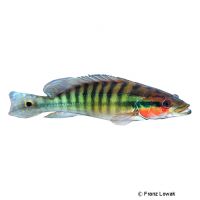Striped Pike Cichlid (Crenicichla strigata)
| Striped Pike Cichlid Crenicichla strigata | |
|---|---|
| Name | Striped Pike Cichlid |
| Name Lat. | Crenicichla strigata |
| Family | Cichlids |
| Family lat. | Cichlidae |
| Order | Cichlids |
| Order lat. | Cichliformes |
| Origin | Brazil, Guyana |
| Habitat | Rivers, oxbow lakes |
| Diet | Omnivore |
| pH | 6.0-7.0 |
| Behavior | Predatory, aggressive |
| Keeping | Individual, pair |
| Care Level | Moderate |
| Reproduction | Cave spawner |
| Breeding | None reported |
| Life Span | 8-10 years |
| Protection | No |
| Metric Units | |
| Size | 30-40 cm |
| Temperature | 23-28 °C |
| Hardness | 5-15 °dH |
| Aquarium | ~ 500 l |
| US Units | |
| Size | 12"-16" |
| Temperature | 73-82 °F |
| Hardness | 89-267 ppm |
| Aquarium | ~ 130 gal |
Distribution and habitat
Striped crested cichlids are common in tributaries of the Amazon River in Guyana and northern Brazil. They live in still water of rivers with sandy bottoms, dead wood, aquatic plants and overhanging riparian vegetation
Maintenance
The aquarium should have a robust border planting, with caves, stones and roots, which provide shelters and hiding places and sufficient free swimming space. A deep substrate of sand or fine gravel, suitable for digging, covered with some foliage (e.g. sea almond tree, beech), some shaded light (floating plants) and a weak current is ideal.
No ammonia, ammonium and nitrite should be detectable, the nitrate value should not exceed 100 mg/l. To ensure the water quality and oxygen content, a filter and heater adapted to the aquarium size is required, as well as lighting for the species-appropriate day-night rhythm of the animals.
Diet
They are lurking hunters. The food supply consists of live and frozen food. For a balanced diet, according to their size, feed once a day with Tubifex, mosquito larvae, krill, shrimp, earthworms, crab and fish meat, etc. (live or frozen). Dry food (pellets, granules, etc.) is rarely accepted.
Only feed as much as will be eaten within a few minutes. Regular and varied feeding promotes health and increases resistance.
Behaviour and compatibility
They are intraspecific and also incompatible with other fish. Especially at spawning time, the territory is fiercely defended. They should be kept singly or in pairs. Juveniles can also be kept in a group. Keeping several pairs is only recommended in a larger and richly structured tank. Socialization is only possible with larger and robust fish, too small fish are considered prey.
Basically, only compatible fish species with similar demands on water quality and water temperature may be socialized.
Sex dimorphism
The sexes can be distinguished only from a length of about 30 cm. The females then have a red-violet colored belly.
Reproduction and breeding
Breeding in the aquarium is said to have succeeded occasionally. They spawn in caves (cave breeders). The female takes care of the brood, while the male defends the territory. The young fish are guarded by both parents for some time
Important
The narrow dark longitudinal stripes and rows of dots on the forehead and sides of the head of the young give them their name.
The well-being of the fish should be checked regularly. Temperature should be checked daily, pH, hardness and nitrate levels at least fortnightly. Regular partial water changes are recommended, even if the contaminant level has not yet reached the upper limit. Sudden changes in water quality should be avoided. Newly introduced fish must be accustomed slowly to the water in the aquarium.
Further literature can be found in your pet store.
References
Text: Werner Winter; Image: Franz Lowak
Source: BMELV (1998): Tierschutzgutachten - Haltung von Zierfischen (Süßwasser); RIEHL & BAENSCH (2004): Aquarien Atlas Bd. 1, Mergus Verlag; ENGELMANN (2005): Zootierhaltung - Tiere in menschlicher Obhut: Fische, Verlag Harri Deutsch
- Gemäß § 21 Abs. 5 Tierschutzgesetz idgF
